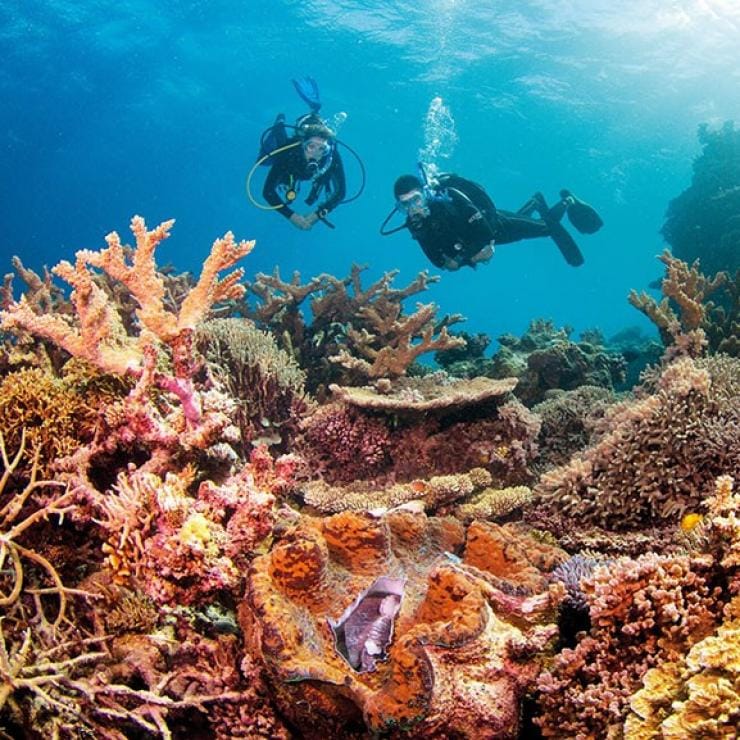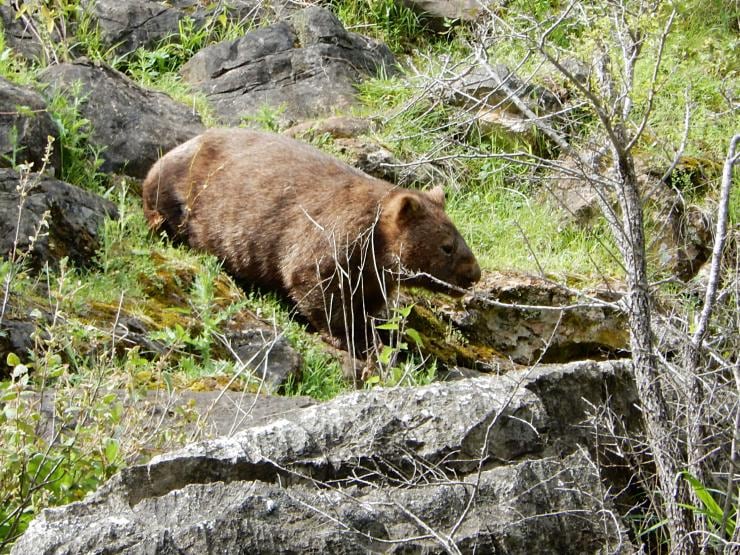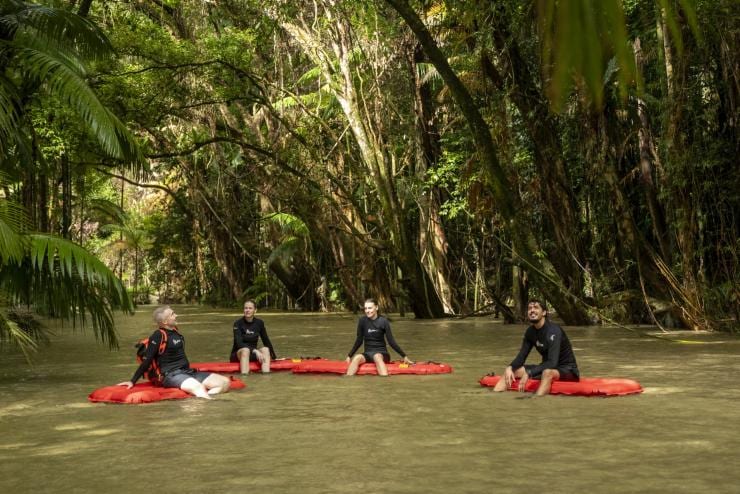
You Yangs Regional Park, Victoria © Koala Clancy Foundation
How to support Australia’s wildlife
Whether you’re planning a meaningful Australian holiday or looking to make a difference from home, here’s how you can support Australia’s wildlife.
By Sarah Reid
Volunteering on holiday offers an opportunity to connect more deeply with the places you visit and the people who live there, while also making a positive impact. Australia has lots of meaningful volunteer options to choose from, even if you’re short on time.
Here are a few top picks – including some great options if you’ve got a soft spot for Aussie wildlife or you want to get started from home.
Help protect the Great Barrier Reef

Clam Gardens, Great Barrier Reef, Queensland © Tourism and Events Queensland
Providing a home for more than 1,625 fish species alone, Queensland’s Great Barrier Reef is one of the world’s most important marine ecosystems, meaning its protection is paramount. A small environmental management charge (EMC) is applied to all reef tours to support reef conservation projects. This means every visitor helps to conserve this natural wonder, but if you’d like to do more, you can also sign up to a range of reef-based citizen science projects, which offer non-scientists an opportunity to contribute to scientific research.
On a five-day expedition with Earthwatch Australia, which pairs researchers with volunteers to address pressing environmental challenges, you’ll snorkel or scuba dive alongside researchers at reefs surrounding Magnetic Island, off Townsville, to help measure environmental conditions, remove algae, and assist with other initiatives designed to protect the Great Barrier Reef for the future.
Protect Kangaroo Island’s endangered species

Koalas, Kangaroo Island, South Australia © Exceptional Kangaroo Island
Did you know?
You can bing Kangaroo Island to your living room by tuning in to one of the many Exceptional Kangaroo Island virtual tours available.

South Australia’s Kangaroo Island is a wildlife wonderland – and you can help protect the animals and their environment. Join eco-tourism operator Exceptional Kangaroo Island on a three-day conservation tour. Feast your eyes on some of the most phenomenal Australian animals, most of which are endemic to the island, and support endangered species including the Kangaroo Island dunnart marsupial and glossy black-cockatoo bird.
Plant trees for koalas in Victoria

Koala Conservation day, Koala Clancy Foundation, near Melbourne, Victoria © Koala Clancy Foundation

Top tip
Join the Echidna Walkabout Nature Tour in Victoria’s East Gippsland to support a variety of Australian animals while you immerse yourself in their natural habitat.
The habitats of koalas, one of Australia’s most iconic species, are increasingly threatened by the likes of bushfires. You can play an active role in conserving koalas in Victoria by booking a Koala Recovery Experience with eco-tour operator Echidna Walkabout. Choose between a one, two or three-day experience, all of which involve planting koala food trees in important habitats near Melbourne in the morning, followed by koala and other wildlife-spotting walks in the afternoon. In fact, you can help to conserve koalas on all tours run by Echidna Walkabout, with a percentage from each tour supporting the Koala Clancy Foundation, a charity which plants trees for koalas and advocates for koala protection.
Help care for injured Tasmanian wildlife

Tasmanian Devil joey, Stanley, Tasmania © Jewels Lynch
Ever dreamed of bottle-feeding a Tasmanian devil? On Ocean 2 Earth’s Tasmanian Wildlife and Penguin Care volunteer project, based at a shelter for unwell, injured, displaced and orphaned wildlife in Bicheno, 2.5 hours’ drive north-east of Hobart, you’ll be working alongside experts for two weeks, offering plenty of opportunities to get close to Tasmania’s unique wildlife while helping to ensure its survival.
If you don’t have two weeks, you can still help Tassie’s wildlife on a day trip by visiting the Tasmanian Devil Unzoo in Taranna, an hour’s drive from Hobart. This unconventional zoo, or “unzoo”, which allows visitors to observe free-ranging wildlife without cages, is also involved in conservation efforts such as monitoring wild Tasmanian devils.
Become a dolphin watcher on the east coast

Dolphin Research Exhibition, Moreton Bay © Dolphin Research Australia
Working to protect dolphins and other marine species, Dolphin Research Australia offers budding citizen scientists an opportunity to contribute to the existing body of scientific knowledge by reporting dolphin sightings in northern New South Wales and south-east Queensland. Simply log the details of your sighting (and a photo if you managed to snap one) on the charity’s website, and the data will be used by scientists to learn more about dolphin behaviour, and how to better protect them. You can also volunteer to join one of Dolphin Research Australia’s multi-day Dolphin Research Expeditions in Moreton Bay, off Brisbane.
Help monitor feral predators in South Australia

Arkaba, Flinders Ranges, South Australia © Wild Bush Luxury
Read next
7 great holiday ideas for the conscious traveller
Set on a sprawling private wildlife conservancy (a term for private land whose owners are dedicated to its protection) in the Flinders Ranges, a five-hour drive north of Adelaide, the beautifully restored Arkaba homestead makes a luxurious base for exploring one of South Australia’s most dramatic landscapes.
A conservation levy is built into the rate and is invested back into Arkaba’s regeneration and conservation projects. This means every guest plays a role in protecting the vast outback property’s biodiversity, but you can also opt to take part in hands-on conservation activities with Arkaba’s knowledgeable guides. These activities can include tracking a radio-collared feral cat to better understand – and minimise – the terrible impact these pests have on wildlife such as ground-dwelling bird species and small marsupials. Or you might join a biologist on field surveys to monitor the effectiveness of Arkaba’s conservation programs as native plants and wildlife return with a flourish.
Volunteer to keep our beaches and waters plastic-free

Beach clean-up, Byron Bay, New South Wales © Take 3 for the Sea
Australia also offers a range of volunteering options that you can undertake whenever you want. Marine debris action organisation Take 3 for the Sea encourages you to pick up and thoughtfully dispose of three pieces of rubbish every time you visit a beach, or anywhere you can make a difference, to help reduce the devastating impact of plastic waste on our oceans and marine life.
If you’d rather combine tackling plastic pollution with meeting locals, Australian not-for-profit Boomerang Bags encourages people to join reusable-bag-making workshops around the country.
Help endangered woodland species in Canberra

Mulligans Flat Woodland Sanctuary, Canberra, Australian Capital Territory © Tourism Australia
Just 50 minutes outside of Canberra's city sits Mulligans Flat Woodland Sanctuary – Australia’s largest single Box-gum Grassy-woodland area. Through ongoing research and support, the sanctuary has recovered a thriving ecosystem for endangered native wildlife to survive and flourish. Among the woodlands, you’ll find wildlife from shingleback lizards to eastern quolls and short-beaked echidnas.
The sanctuary offers a host of opportunities to get involved with its wildlife conservation. Help to monitor and identify species, get your hands dirty by helping to maintain the sanctuary’s ecosystem or, if you fancy yourself a tour guide, try your hand at hosting educational tours for the public.
Make a difference from overseas

Lizard Island, Great Barrier Reef, Queensland © Tourism Australia
Conservation experiences can make for a memorable holiday, but what can you do from home? Luckily, you don’t have to be Down Under to support Australia’s wildlife and eco-systems. At Australian wildlife hospitals including the Irwin family's Australia Zoo, you can donate to support wildlife in need of specialised care or rehabilitation. And through the Port Macquarie Koala Hospital in New South Wales, you can adopt a koala – even from overseas.
And it’s not just our friends above the land who you can support, but those beneath the surface. Become a ‘Citizen’ of the Great Barrier Reef and join people across the globe on their mission to protect the world’s largest reef and its spectacular marine life. Sign up with Citizens of the Great Barrier Reef and start with six simple actions, from carrying your own cup to banishing the bag, it’s conservation made easy.

































































































































